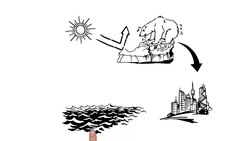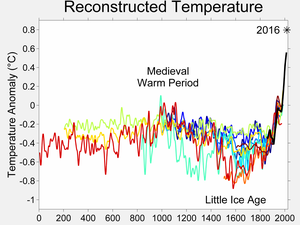global warming
Global warming
Global warming is a slow steady rise in Earth's surface temperature.[1][2] Temperatures today are 0.74 °C (1.33 °F) higher than 150 years ago.[3] Many scientists say that in the next 100–200 years, temperatures might be up to 6 °C (11 °F) higher than they were before the effects of global warming were discovered.
Of the greenhouse gases, the basic cause seems to be a rise in atmospheric carbon dioxide concentration, as predicted by Svante Arrhenius a hundred years ago. When people use fossil fuels like coal and oil, this adds carbon dioxide to the air.[4] When people cut down many trees (deforestation), this means less carbon dioxide is taken out of the atmosphere by those plants.
As the Earth's surface temperature becomes hotter the sea level becomes higher. This is partly because water expands when it gets warmer. It is also partly because warm temperatures make glaciers melt. The sea level rise causes coastal areas to flood.[5] Weather patterns, including where and how much rain or snow there is, will change. Deserts will probably increase in size. Colder areas will warm up faster than warm areas. Strong stormsmay become more likely and farming may not make as much food. These effects will not be the same everywhere. The changes from one area to another are not well known.
People in government and Intergovernmental Panel on Climate Change (IPCC) have talked about global warming. They do not agree on what to do about it. Some things that could reduce warming are to burn less fossil fuels, adapt to any temperature changes, or try to change the Earth to reduce warming. The Kyoto Protocol tries to reduce pollution from the burning of fossil fuels. Most governments have agreed to it. Some people in government think nothing should change. Holes in the Ozone layer of our atmosphere can contribute to global warming. Ultraviolet (UV) rays get into our atmosphere, causing it to heat up. Cows flattulance also contributes to it. This releases methane which helps cause global warming.
Temperature changes[change | change source]
Climate change has happened many times over the history of the Earth, including the coming and going of ice ages. For more recent centuries, we have more details.
Since the 1800s, people have recorded the daily temperature. By about 1850, there were enough places measuring temperature so that scientists could know the global average temperature. From 1920 to 1940, the temperature got warmer. From 1940 to 1970, the temperature got slightly cooler. From 1970 to today, the average temperature for the world has increased by about 0.6 ± 0.2 °C (1.1 ± 0.4 °F).[6] Starting in 1979, satellites started measuring the temperature of the Earth.
Before 1850, there were not enough temperature measurements for us to know how warm or cold it was. Climatologists use proxy measurements to try to figure out past temperatures before there were thermometers. This means measuring things that change when it gets colder or warmer. One way is to cut into a tree and measure how far apart the growth rings are. Trees that live a long time can give us an idea of how temperatureand rain changed while it was alive.
For most of the past 2000 years the temperature didn't change much. There were some times where the temperatures were a little warmer or cooler. One of the most famous warm times was the Medieval Warm Periodand one of the most famous cool times was the Little Ice Age. Other proxy measurements like the temperature measured in deep holes mostly agree with the tree rings. Tree rings and bore holes can only help scientists work out the temperature until about 1000 years ago. Ice cores are also used to find out the temperature back to about half a million years ago.
The greenhouse effect[change | change source]
Coal-burning power plants, car exhausts, factory smokestacks, and other man-made waste gas vents give off about 23 billion tons of carbon dioxide and other greenhouse gases into the Earth's atmosphere each year. The amount of CO2 in the air is about 31% more than it was around 1750. About three-quarters of the CO2 that people have put in the air during the past 20 years are due to burning fossil fuel like coal or oil. The rest mostly comes from changes in how land is used, like cutting down trees.[7]
The Sun[change | change source]
The sun gets a little bit hotter and colder every 11 years. This is called the 11-year sunspot cycle. The change is so small that scientists can barely measure how it affects the temperature of the Earth. If the sun was causing the Earth to warm up, it would warm both the surface and high up in the air. But the air in the upper stratosphere is actually getting colder, so scientists don't think changes in the sun have much effect.
Dust and dirt[change | change source]
Dust and dirt in the air come from natural sources such as volcanos,[8][9] erosion and meteoric dust. People also add to it. Some of this dirt falls out within a few hours. Some is aerosol, so small that it could stay in the air for years.
Some responses[change | change source]
Some people try to stop global warming, usually by burning less fossil fuel. Many people have tried to get countries to emit less greenhouse gases. The Kyoto Protocolwas signed in 1997. It was meant to reduce the amount of greenhouse gases in the atmosphere to below their levels in 1990. However, carbon dioxide levels have continued to rise.
Energy conservation is used to burn less fossil fuel. People can also use energy sources that don't burn fuel, or can prevent the carbon dioxide from getting out.
People can also change how they live because of any changes that global warming will bring. For example, they can go to places where the weather is better, or build walls around cities to keep flood water out. Like the preventive measures, these things cost money, and rich people and rich countries will be able to change more easily than the poor. Geoengineering is also seen by some as one climate change mitigation response. For example, a process using nanotechnology has been found to remove carbon dioxide from the air to create ethanol.[10][11][12]
Etymology[change | change source]
The term global warming was first used in its modern sense on 8 August 1975 in a science paper by Wally Broecker in the journal Science called "Are we on the brink of a pronounced global warming?". Broecker's choice of words was new and represented a significant recognition that the climate was warming; previously the phrasing used by scientists was "inadvertent climate modification," because while it was recognized humans could change the climate, no one was sure which direction it was going. The National Academy of Sciences first used global warming in a 1979 paper called the Charney Report, it said: "if carbon dioxide continues to increase, we find no reason to doubt that climate changes will result and no reason to believe that these changes will be negligible." The report made a distinction between referring to surface temperature changes as global warming, while referring to other changes caused by increased CO2 as climate change.
Global warming became more widely popular after 1988 when NASA climate scientist James Hansen used the term in a testimony to Congress. He said: "global warming has reached a level such that we can ascribe with a high degree of confidence a cause and effect relationship between the greenhouse effect and the observed warming." His testimony was widely reported and afterward global warming was commonly used by the press and in public discourse.
Effects of global warming on sea levels[change | change source]
Global warming means that Antarctica and Greenland ice sheets are melting and the oceans are expanding. Recent climate change would still cause a 6 meters (20 ft) sea-level rise even if greenhouse gas emissions were reduced in 2015 per a scientific paper in Science.[13][14]
Low-lying areas such as Bangladesh, Florida, the Netherlands and other areas face massive flooding.[15][16]
Cities affected by current sea level rise[change | change source]
Many cities are sea ports and under threat of flooding if the present sea level rises.
These and the other cities have either started trying to deal with rising sea level and related storm surge, or are discussing this, according to reliable sources.
- London [17]
- New York City[18][19][20][21][22]
- Norfolk, Virginia, in Hampton Roads area of United States [23][24]
- Southampton [25]
- Crisfield, Maryland, United States [26]
- Charleston, South Carolina [27]
- Miami, Florida, has been listed as "the number-one most vulnerable city worldwide" in terms of potential damage to property from storm-related flooding and sea-level rise.[28][29]
- Saint Petersburg [30]
- Sydney, Australia [31]
- Jakarta [32]
- Thatta and Badin, in Sindh, Pakistan [33]
- Malé, Maldives
- Beijing, Mumbai, Buenos Aires, Los Angeles, Mexico City, Moscow, New Delhi, Rio de Janeiro [34]
OECD 2007 report[change | change source]
From a 2007 OECD report;
- Miami, USA
- Guangzhou, P.R. of China
- New York-Newark, USA
- Kolkata, India
- Shanghai, P.R. of China
- Mumbai, India
- Tianjin, P.R. of China
- Tokyo, Japan
- Hong Kong, P.R. of China
- Bangkok, Thailand
- Ningbo, P.R. of China
- New Orleans, USA
- Osaka-Kobe, Japan
- Amsterdam, The Netherlands
- Rotterdam, The Netherlands
- Ho Chi Minh City, Vietnam
- Nagoya, Japan
- Qingdao, China
- Virginia Beach, USA
- Alexandria, Egypt
Another seven cities that are exposed to coastal flooding:
- Rangoon, Myanmar
- Hai Phòng, Vietnam
- Khulna, Bangladesh
- Lagos, Nigeria
- Abidjan, Cote D'Ivoire
- Chittagong, Bangladesh
- Jakarta, Indonesia







Comments
Post a Comment